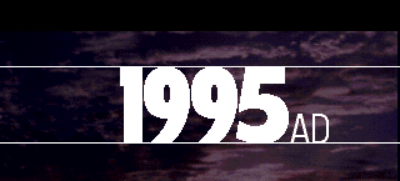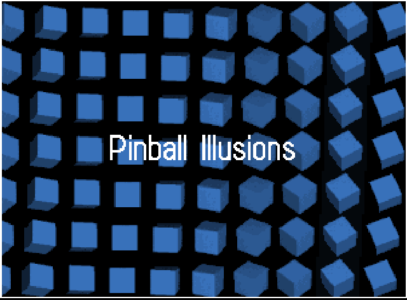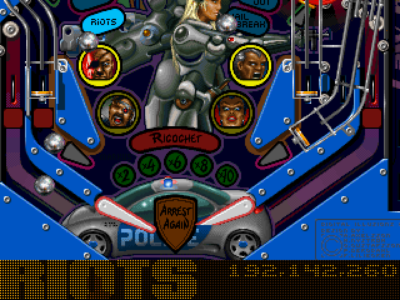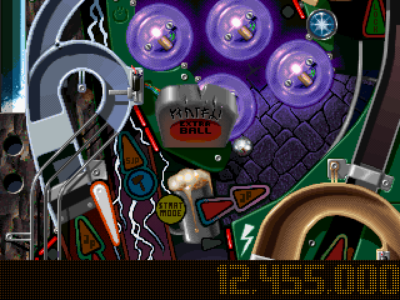Written by: Rik
Date posted: May 26, 2014
As one of the older reviews on the site, my original write-up of this one wasn’t, perhaps, the best. Our policy on such things is not go back and re-write, no matter how much the temptation may strike – not because they couldn’t be improved, but more in recognition of the fact that time would better be spent on new content (updates are scarce enough as it is) rather than replaying those already covered and tinkering with words already written. Personally, my feeling is that as long as I’m happy with the gist of what was said at the time, then I can – reluctantly – live with the fact that it could have been done a lot better.
When this review was written, I had no idea that FFG would still be going 12 years later, or indeed that Pinball Illusions was my favourite pinball game for any reason other than it was the first one I played for any length of time. So while I did include some of the key general points – yes, 21st Century Entertainment did release a lot of pinball games in the 90s; no, I don’t care for real pinball; yes, there is some mad techno music which is also awesome; and yes, it’s so easy to get into that I felt confident enough to boast about my abilities on the first table (a boast that I now retract), it’s also a little short on detail, and my praise is also a little understated.
Criminally, there’s no mention of the laughably bombastic introduction, which refers to Digital Illusions’ previous pinball titles, Dreams and Fantasies, as if they were created On The Second Day by God Himself, before segueing into a trippy menu screen backed by some truly rave-tastic music (I’d love to post a clip but several resolution changes do something weird to the DOSBox video capture). And, while we’re talking about the menu music, I do also like the switch to a low-key chill-out track when you return to the menu from the game.
As for the tables themselves, well, Law and Justice remains my favourite. From a technical standpoint, it’s pretty clear what you have to do, with access to the central point-scoring modes unlocked with an easy combo, and from there the ramps you have to target are lit up with big red arrows. On top of that, there’s a cool futuristic police theme, with appropriate music and police tracker samples, while there are some nifty animations on the LED display – with the occasional mini-game thrown in for good measure. Maybe I just like it because it’s easy, or I’m relatively good at it, or both – but even replaying it now, it had me coming back for more.
Barring the slightly distasteful name (I blame Hasselhoff), Babewatch is also a pretty good table. It’s still fairly easy to understand what’s going on, although points are slightly more harder-earned than in Law and Justice. Again, the music is both appropriate and nicely done, and I like the way that the tune changes at various points when you’ve activated a certain mode, such as the bit where you have to do weightlifting like a big butch man.
I never really got on with the Extreme Sports table at the time, perhaps because it’s harder going than the previous two mentioned, and I never managed to make much headway. It now strikes me as more similar in style to some of the tables in Pinball Fantasies, and while revisiting it since playing Fantasies, I did manage more significant success than previously. Certainly, you need to concentrate on what you’re doing at all times just to even get access to big points, never mind securing them. The music is fairly industrial sounding, although the flourish when your ball goes down the drain is reminiscent of a Pepsi Max advert from the 90s (which is kind of appropriate when you think about it, as extreme sports were once used in marketing as part of the ongoing attempt to make a diet cola seem more exciting and masculine and somehow remove any stigma associated with drinking it).
As a disciple of the three-table disk version, I had never realised that a CD version was released which included a fourth, The Vikings. Apparently work on this table was completed by Frontline (who ported Illusions to the PC) rather than Digital Illusions – a telltale sign is the fact that the developers’ names are missing from the bottom right-hand corner of the table in-game. I personally didn’t have much time for it, although it does have some enjoyably bonkers music.
In terms of general points, Illusions looks a lot slicker than previous efforts, with the dull grey blob of Fantasies now replaced by a shinier, chrome-ier ball. The tables all have multiball modes, which means – in case it wasn’t obvious – you can have a number of balls active on the table at once, under certain circumstances. Also, it’s more generous than Fantasies in terms of giving you a freebie if you have the misfortune of losing the ball down the drain a short time after you’ve released it.
Apparently, this was supposed to be the last big hurrah for the Pinball Dreams series – an ultimate version of the template, if you like (this is even hinted at in a jokey reference to ‘Super Pinball Fantasies Turbo EX II M-Ball Edition’ in the Amiga version intro). Ok, so maybe I’m not enough of a flipperhead (or whatever they call people who like pinball) to go through the technical stuff in forensic detail, and maybe I have a nostalgia-fuelled soft spot for this one, but in my opinion, that’s exactly what Illusions is. So: BEST PINBALL GAME EVERRRR!!!!! (out of the handful that I’ve played).
(I try not to link to YouTube videos in case they disappear later, but I really want to include one of the intro. NB This is the Amiga version…)






 Posts
Posts